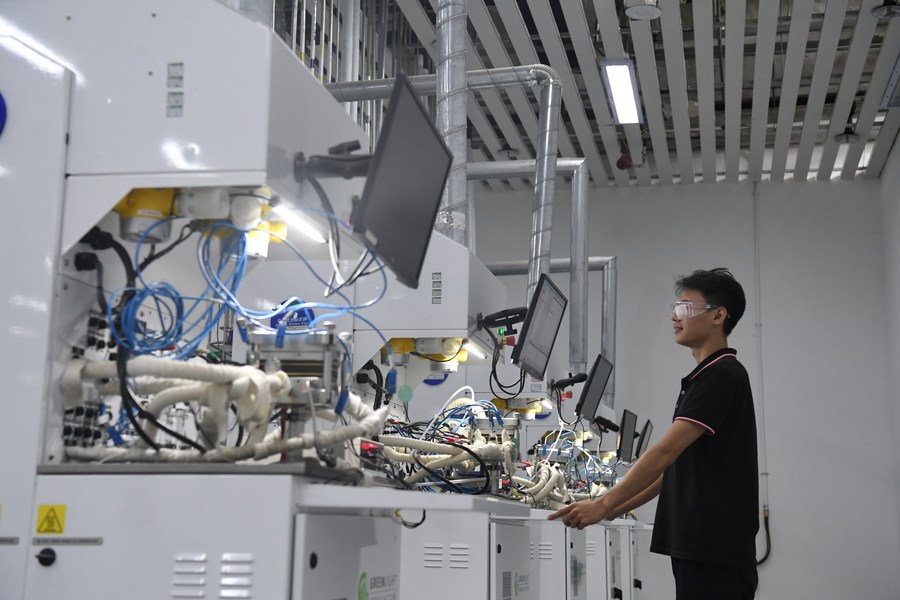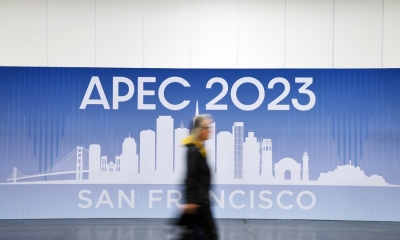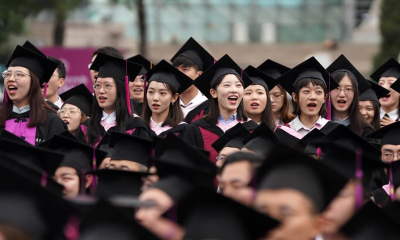China’s Decade of Explosive Growth

In poll after poll, Chinese citizens rate their governments at all levels highly.
The passage of one decade compared to the long sweep of China’s storied history of more than 3,000 years is the mere blink of an eye. But the accomplishments of the last ten years beginning with the 18th National Congress of the Communist Party of China (CPC) in November, 2012 have added immeasurably to China’s historic achievements. I’ve been pleased to personally witness these profound changes unfold since 1988 when China was only near the beginning of its meteoric rise after a trying century of humiliation.
For millennia, Chinese people dreamed of crafting a “moderately prosperous society” in all respects. Even at the dawn of the 21st century, most experts saw this goal as a veritable mission impossible. However, concurrently with Xi Jinping’s election as Chinese leader, the 18th CPC National Congress made achieving this goal its primary objective.
Wellbeing for all people
President Xi explained the idea at the 19th CPC National Congress in October 2017. He said that building a moderately prosperous society in all respects meant promoting social fairness and justice, as well as ensuring steady access to childcare, education, employment, medical service, elder care, housing and social assistance. He pledged to “intensify poverty alleviation, see that all our people have a greater sense of fulfillment as they contribute to and gain from development, and continue to promote well-rounded human development and common prosperity for everyone.”
By 2020 China made this age-old dream a reality by completely eliminating extreme poverty from the smallest rural village to its largest megacity in the short span of four decades. That’s nearly 800 million economically uplifted people, more than half of the country’s total population of 1.4 billion and almost three-quarters of the world total. In doing so, China not only benefitted the largest number of people in human history, but at the same time became the first developing country to achieve United Nations Sustainable Development Goal One: extreme poverty elimination. In China, actions speak louder than empty words or unfulfilled promises!
Poverty elimination obviously doesn’t exist in a vacuum but has broad consequences. Although not the only factor because variables like governance and economic achievement are important too, eliminating poverty has knock-on effects to related measurements of social progress.

Life expectancy at birth (LEB) is a widely recognized, broad socio-economic measure reflecting a nation’s wellbeing. LEB includes factors such as health and disease metrics, nutrition, living standards, and education. At China’s founding in 1949, its LEB was only 35 years. By way of comparison in the U.S. that year it was 68, almost twice as long a lifetime as in China, a country with more than three times the U.S. population. Fast forward to today. Both countries are tied for LEB at about 77 years with China’s population having grown to four times greater than the U.S.
Literacy is also another measure of social progress. Being literate is directly correlated to one’s ability to get a decent job and to climb the ladder of success. In 1950 China’s literacy rate was about 20 percent. Today China’s rate is 96.8 percent and the U.S. is 88 percent. China’s neighbor, India was at about the same literacy level at its founding, but today is at about 75%. China’s achievement is amazing, considering both the low starting point and that Mandarin is so much more challenging requiring memorizing thousands of unique characters.
Achievement in science and technology
China has also recognized that scientific achievement is a key to national progress and rejuvenation. President Xi has said “Science and technology are the bedrock upon which a country relies for its strength, enterprises for success, and people for a better life. Great scientific and technological capacity is a must if we are to make China strong and improve our lives.”
So, it’s no surprise that China has doubled down in these areas and recent results are impressive. China, for example is aiming to be the world leader in artificial intelligence by 2030 and global high-tech leader by 2050. China is making efforts to shift the country from being “the world’s factory” for low quality goods to being a leader in high quality, locally-produced, technologically-intensive products and services, especially using advanced microchip technology, robotics and the like.
China’s model for success is based on increased spending on research and development and spending to educate a new generation of achievers in science, technology, engineering and mathematics (STEM). Indeed, China, now number two behind the U.S., is on track to becoming the leading global funder of R&D by 2025.
According to the U.S. National Science Board, China passed U.S. expenditures in R&D in 2019 for the first time. China contributed 32 percent of all R&D spending growth since 2000, compared with 20 percent for the U.S. and 17 percent for the EU. Going forward, OECD projections show that the highest share of students with STEM degrees in the OECD and G20 countries will be: China, 37 percent; India, 26.7 percent, Russia, 4.5 percent; the U.S., 4.2 percent and Indonesia, 3.7 percent. Results are now becoming apparent. Today, China is producing over 50,000 PhD STEM grads per year, and is on track to have twice the STEM PhDs as the U.S. by 2025. The U.S. grants about 33,000 STEM PhDs annually, but has a far lower growth rate of PhDs candidates.

China’s actions are unsurprisingly already producing a rich intellectual property harvest. China had already surpassed the U.S. in the sheer number of scientific papers produced back in 2017, but this August 9, Japan’s National Institute of Science and Technology Policy went further in zeroing-in on the volume of leading edge, Nobel Prize quality papers a country had authored. Their report found that 27.2 percent of the top 1 percent of most-cited scientific papers in 2019 came from Chinese institutions with the U.S. in second place with 24.9 percent.
Patent filings are also indicative of the scientific output of a nation. In a parallel trend, China filed 69,540 of 277,500 global patents last year followed by the U.S. at 59,570. China had surpassed the U.S. in 2019.
What has been the U.S. latest reaction? Due to political paralysis in Washington, not much until August 9 when President Biden signed the $280 billion CHIPS and Science Act. Fair enough that it begins to fund the considerable U.S. talent and research deficit. Normally, competition is good. But as is so often the case lately, the law also attempts to further deny China a level playing field and tie one hand behind its back; for example, forbidding U.S. and foreign companies benefitting from the law’s rich subsidies from producing even semi-advanced chips in China and Russia for a ten-year period.
One of the most serious existential global threats is environmental catastrophe. Here too China is leading the way, so much so that it’s expected to meet its 2030 Paris Climate Agreement targets by 2026. For example, China built as much renewable energy as the rest of the world combined in 2021. Today China is building more nuclear power plants than the rest of the world combined. China has hundreds of EV companies and of the 6.8 million vehicles produced globally last year, 3.5 million were sold in China, compared to 631,000 in America. China has half a million electric buses in use, the U.S. less than 1,500. China has started a carbon emissions market that’s already triple the size of Europe’s. The U.S. has no national carbon market in place.
China has its nonpolluting Fuxing high-speed electric train that travels at 350+ km/hour. By contrast, the US has AMTRAK, a national disgrace that Biden took hundreds of times as Senator from Wilmington to Washington in 74 minutes, a trip that in China today would take 28 minutes. And it seems that it’s China that’s building back better with a planned low-vacuum magnetic levitation train using superconducting magnetic levitation technology that will travel 1,000 km/hour.
China’s accomplishments aren’t only here on Earth; some are literally out of this world. In 2019, China was the first country to land a spacecraft on the dark side of the moon. In 2020, China completed Beidou, its own satellite-based global navigation system. China plans to send its first crewed mission to Mars in 2033, build a base there and follow with regular crewed missions.

CPC leadership wins support from citizens
How have so many of China’s achievements occurred in the same period when some other powerful countries today find themselves merely treading water, or in a state or crisis or decline? China’s secret sauce is its whole process democracy led by the CPC, now in its 101st year. Democracies come in many shapes and sizes reflecting the unique nature of each society. Here, one size doesn’t fit all.
Since 1953 when China’s per capita income was $54, not today’s $10,000, the CPC has steadily perfected the management tool of Five-Year Plans. The CPC is powered by its intensive human resources apparatus that only rewards those who have successfully demonstrated higher and higher levels of public service.
This is not just a bunch of propaganda as some would have others believe. In poll after poll, Chinese citizens rate their governments at all levels highly.
A long-term Harvard University Kennedy School of Government study released in 2020 examined the relationship between Chinese citizens and the CPC from 2003 to 2016. The study found a near-universal rise in average satisfaction toward all four levels of the Chinese government – township, county, province, and central levels – in this period based on more than 31,000 interviews in both urban and rural areas. For example, in 2016, 93.1 percent of respondents were either “relatively satisfied” or “highly satisfied” with the central government’s performance, representing an increase of 7 percent from 2003. In the same period, township governments, the lowest level examined, received the approval of 44 percent of respondents in 2003, but jumped to 70 percent in 2016, 26 percent higher.
In another survey, the 2022 edition of the 22-year-old Edelman Trust Barometer (ETB), Edelman asked respondents in 27 countries to indicate how much they trusted their own country’s NGOs, business, government and media “to do what is right”. In the latest ETB, China scored highest at 83 percent, up 11 percent from 2021. The U.S. scored 43 percent, down 5 percent Year-on-Year (and a 10 percent drop from 2017). In fact, the overall 40-point trust level divergence between the two countries has never been greater. Between China and the U.S., the biggest divergence in the four components was of respondents’ trust in their respective governments, 91 percent for China and 39 percent for the U.S., a 52 percent difference.
Far from being over, the work of the CPC continues. While it has successfully built a moderately prosperous society in all respects, its next goal is to “build a modern socialist country that is prosperous, strong and culturally advanced and harmonious” by 2049. If past is prologue, this momentous goal will also be achieved.
The article reflects the author’s opinions, and not necessarily the views of China Focus.
 Facebook
Facebook
 Twitter
Twitter
 Linkedin
Linkedin
 Google +
Google +








